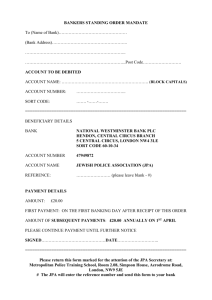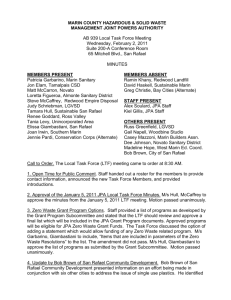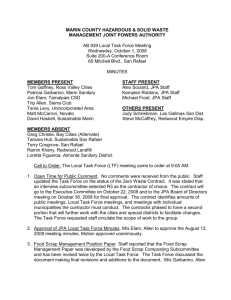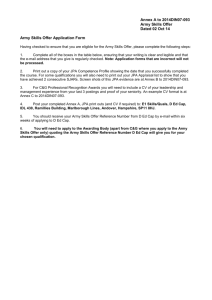Ann. Funct. Anal. 4 (2013), no. 2, 171–182 SPACE
advertisement
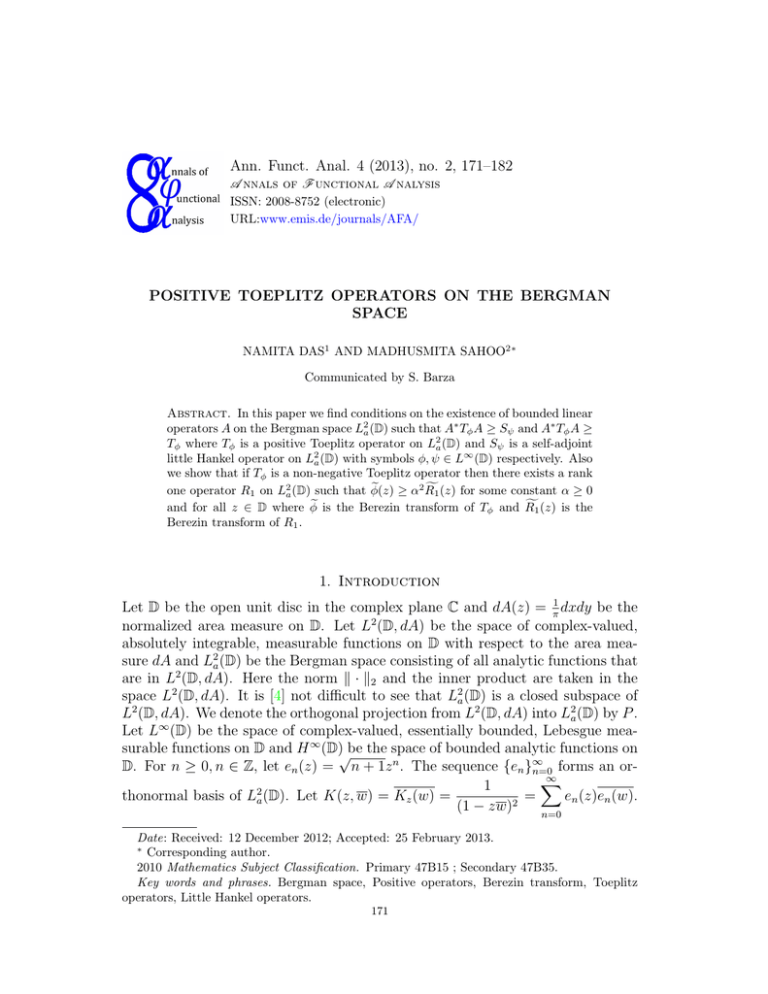
Ann. Funct. Anal. 4 (2013), no. 2, 171–182
A nnals of F unctional A nalysis
ISSN: 2008-8752 (electronic)
URL:www.emis.de/journals/AFA/
POSITIVE TOEPLITZ OPERATORS ON THE BERGMAN
SPACE
NAMITA DAS1 AND MADHUSMITA SAHOO2∗
Communicated by S. Barza
Abstract. In this paper we find conditions on the existence of bounded linear
operators A on the Bergman space L2a (D) such that A∗ Tφ A ≥ Sψ and A∗ Tφ A ≥
Tφ where Tφ is a positive Toeplitz operator on L2a (D) and Sψ is a self-adjoint
little Hankel operator on L2a (D) with symbols φ, ψ ∈ L∞ (D) respectively. Also
we show that if Tφ is a non-negative Toeplitz operator then there exists a rank
e
f1 (z) for some constant α ≥ 0
≥ α2 R
one operator R1 on L2a (D) such that φ(z)
f1 (z) is the
and for all z ∈ D where φe is the Berezin transform of Tφ and R
Berezin transform of R1 .
1. Introduction
Let D be the open unit disc in the complex plane C and dA(z) = π1 dxdy be the
normalized area measure on D. Let L2 (D, dA) be the space of complex-valued,
absolutely integrable, measurable functions on D with respect to the area measure dA and L2a (D) be the Bergman space consisting of all analytic functions that
are in L2 (D, dA). Here the norm k · k2 and the inner product are taken in the
space L2 (D, dA). It is [4] not difficult to see that L2a (D) is a closed subspace of
L2 (D, dA). We denote the orthogonal projection from L2 (D, dA) into L2a (D) by P .
Let L∞ (D) be the space of complex-valued, essentially bounded, Lebesgue measurable functions on D and H ∞ (D)√be the space of bounded analytic functions on
D. For n ≥ 0, n ∈ Z, let en (z) = n + 1z n . The sequence {en }∞
n=0 forms an or∞
X
1
2
thonormal basis of La (D). Let K(z, w) = Kz (w) =
=
en (z)en (w).
(1 − zw)2
n=0
Date: Received: 12 December 2012; Accepted: 25 February 2013.
∗
Corresponding author.
2010 Mathematics Subject Classification. Primary 47B15 ; Secondary 47B35.
Key words and phrases. Bergman space, Positive operators, Berezin transform, Toeplitz
operators, Little Hankel operators.
171
172
N.DAS, M.SAHOO
The function K(z, w) defined on D × D is called the Bergman kernel of D or
K(w, z̄)
1 − |z|2
Kz (w)
the reproducing kernel of L2a (D). Let kz (w) =
=
.
=
K(z, z̄)
(1 − z̄w)2
kKz k2
These functions kz are called the normalized reproducing kernels of L2a (D) for
each z ∈ D. It is clear [10] that they are unit vectors in L2a (D).
For φ ∈ L∞ (D), we define the Toeplitz operator from L2a (D) into itself by
Tφ f = P (φf ) and the Hankel operator Hφ from L2a (D) into (L2a (D))⊥ is defined
by Hφ f = (I − P )(φf ). The little Hankel operator Sφ from L2a (D) into itself
is defined as Sφ f = P (J(φf )) where J : L2 (D, dA) −→ L2 (D, dA) is defined as
Jf (z) = f (z̄). These operators [10] are all bounded.
Let L(H) denote the algebra of all bounded linear operators from the Hilbert
space H into itself. Let LC(H) denote the ideal of compact operators in L(H).
A bounded linear operator A ∈ L(H) is said to be positive if hAx, xi ≥ 0 for all
x ∈ H. The notation A ≥ 0 will mean that A is positive. We say A ≥ B when
hAx, xi ≥ hBx, xi for all x ∈ H. For arbitrary selfadjoint operators A, B ∈ L(H)
we write A ≤ B if and only if B − A ≥ 0. An operator A ∈ L(H) is called
hyponormal if A∗ A ≥ AA∗ and the operator A ∈ L(H) is called power bounded
if kAn k ≤ K for a fixed K > 0 and n = 1, 2, . . . . Let T be a bounded linear
T + T∗
T − T∗
operator on a Hilbert space H. We denote
by Re(T ) and
by
2
2i
2
Im(T ). Define the Berezin transform for operators T ∈ L(La (D)) by the formula
Te(z) = hT kz , kz i, z ∈ D.
The function Te is called the Berezin transform of T . If T ∈ L(L2a (D)) then
Te ∈ L∞ (D) and kTek∞ ≤ kT k as |Te(z)| = |hT kz , kz i| ≤ kT k for all z ∈ D. We
e
fφ = φe for φ ∈ L∞ (D). That is, φ(z)
fφ (z) for all
shall write T
= hTφ kz , kz i = T
z ∈ D.
In the set of bounded Hermitian operators from a Hilbert space H into itself,
various types of ordering by means of the cones of non-negative, positive definite
and positive invertible operators can be defined. In this paper we investigate
whether it is possible to compare the Berezin transform of non-negative Toeplitz
and little Hankel operators. In section 2, we prove a few preliminary lemmas.
In section 3, we show that if Tφ is a positive Toeplitz operator on the Bergman
space and Sψ is a self-adjoint little Hankel operator then there exist bounded
linear operators A ∈ L(L2a (D)) such that A∗ Tφ A ≥ Sψ . Similarly, we show that
there exists A ∈ L(L2a (D)) such that A∗ Tφ A ≥ Tφ . Further, one can find a
w
sequence {An } ∈ L(L2a (D)) such that An −→ 0 and A∗n Tφ An ≥ Tφ for all n. In
section 4, we prove that if Tφ is a non-negative Toeplitz operator in L(L2a (D))
e
f1 (z)
then there exists a rank one operator R1 ∈ L(L2a (D)) such that φ(z)
≥ βR
for all z ∈ D and for some constant β ≥ 0.
2. Preliminary lemmas
In this section we prove a few preliminary lemmas which will be used in proving
the main results of the paper.
POSITIVE TOEPLITZ OPERATORS
173
For finite rank operators in L(L2a (D)) one can define a trace functional tr by
n
n
X
X
tr(T ) =
hfk , gk i when T =
fk ⊗ gk .
k=1
k=1
Lemma 2.1. Let S, T ∈ L(L2a (D)). If tr(ASA) = tr(AT A) for every rank one
projection A ∈ L(L2a (D)), then S = T .
Proof. Let A = f ⊗ f , where f is a unit vector. Then A is a rank one projection
and every rank one projection takes this form. By the assumption, we have
hSf, f i = tr(Sf ⊗ f )
= tr(ASA) = tr(AT A)
= tr(T f ⊗ f )
= hT f, f i .
Thus hSf, f i = hT f, f i holds for every unit vector f ∈ L2a (D). Therefore,
hSkz , kz i = hT kz , kz i for all z ∈ D. Hence S = T .
Lemma 2.2. If Tφ is invertible and hA∗ Tφ−1 Af, gihA∗ Tφ Af, gi = hA∗ Af, gi2 for
every f, g ∈ L2a (D) and for some A ∈ L(L2a (D)) whose range is dense in L2a (D)
then φ is a constant function.
Proof. Since RangeA = L2a (D) we have Tφ−1 f, g hTφ f, gi = hf, gi2 for all f, g ∈
L2a (D). Now fix a nonzero f ∈ L2a (D). Then,
for every
g ∈ (Sp{f })⊥ ⊂ L2a (D),
we have hTφ−1 f, gi = 0 or hTφ f, gi = 0 since Tφ−1 f, g hTφ f, gi = hf, gi2 = 0. Let
Mf = g ∈ (Sp{f })⊥ : hTφ f, gi = 0 and Nf = g ∈ (Sp{f })⊥ : hTφ−1 f, gi = 0 .
Then Mf ∪ Nf = (Sp{f })⊥ . Because (Sp{f })⊥ , Mf and Nf are all closed linear
subspaces, we must have Mf ⊆ Nf = (Sp{f })⊥ or Nf ⊆ Mf = (Sp{f })⊥ .
If Nf = (Sp{f })⊥ , then Tφ−1 f ∈ Sp{f }. So there exists a λf ∈ C such that
⊥
Tφ−1 f = λf f 6= 0, that is, Tφ f = λ−1
f f . If Mf = (Sp{f }) , then Tφ f ∈ Sp{f },
that is, Tφ f = λf f for some scalar λf . Since f is arbitrary, we see that for every
f ∈ L2a (D), there is a scalar λf such that Tφ f = λf f . This implies that there
exists a λ ∈ C such that φ ≡ λ.
Corollary 2.3. Suppose that Tφ is invertible and hSψ+ Tφ−1 Sψ f, gihSψ+ Tφ Sψ f, gi =
hSψ+ Sψ f, gi2 for every f, g ∈ L2a (D) and ker Sψ = {0}. Then φ ≡ C, a constant
function.
Proof. We need only to observe that RangeSψ = L2a (D) if and only if ker Sψ =
{0}.
Lemma 2.4. Let A be a nonnegative operator in L(L2a (D)). Then ker A =
ker A1/2 and RangeA = RangeA1/2 . If RangeA is closed then RangeA1/2 is closed
and RangeA = RangeA1/2 and A = A1/2 B, for some invertible B ∈ L(L2a (D)).
Proof. Since hAf, f i = hA1/2 f, A1/2 f i, f ∈ L2a (D), it follows that ker A ⊆ ker A1/2 .
Conversely, if f ∈ ker A1/2 , we obtain Af = A1/2 A1/2 f = 0. Thus ker A =
ker A1/2 . Also, observe that RangeA = (ker A)⊥ = (ker A1/2 )⊥ = RangeA1/2 .
The lemma follows from [7].
174
N.DAS, M.SAHOO
Lemma 2.5. Let ψ ∈ C(D), the space of continuous functions on D and kψk∞ ≤
1. Let Tφ be a positive Toeplitz operator on L2a (D) such that Tφ ≤ Sψ+ Tφ Sψ where
ψ + (z) = ψ(z̄). Then Tφ = Sψ+ Tφ Sψ . Further RangeTφ reduces Sψ and Sψ |(RangeTφ )
is unitary.
1/2
Proof. Let Tφ Sψ = L. The operator L is compact [10] as ψ ∈ C(D) and Sψ is a
1/2
1/2
contraction as kψk∞ ≤ 1. Further, LL∗ = Tφ Sψ Sψ+ Tφ
≤ Tφ . This is so since
1/2
1/2
Sψ+ Tφ Sψ − Tφ Sψ Sψ+ Tφ = L∗ L − LL∗ .
Sψ∗ = Sψ+ . Hence 0 ≤ Sψ+ Tφ Sψ − Tφ ≤
Hence the operator L is hyponormal. Since L is compact, L is normal. The
1/2
1/2
normality of L implies that Tφ = Sψ+ Tφ Sψ = Tφ Sψ Sψ+ Tφ , and hence it follows
that Sψ+ is an isometry on RangeTφ and Tφ commutes with Sψ (and so also with
Sψ+ ). Consequently, Sψ+ Sψ Tφ = Sψ+ Tφ Sψ = Tφ = Tφ Sψ Sψ+ . Hence RangeTφ
reduces Sψ and Sψ |(RangeTφ ) is unitary.
3. Non-negative Toeplitz operators
In this section we show that if Tφ is a positive Toeplitz operator in L(L2a (D)) and
ψ ∈ L∞ (D) can be expressed as a linear combination of Bergman kernels and some
of its derivative then there exist bounded linear operators A ∈ L(L2a (D)) such that
A∗ Tφ A ≥ Sψ∗ Sψ . If in addition ψ(z) = ψ(z) then we can find A ∈ L(L2a (D)) such
that A∗ Tφ A ≥ Sψ . Further, we find conditions for the existence of A ∈ L(L2a (D))
such that A∗ Tφ A ≥ Tφ . It is also possible to find sequences {An } of operators in
w
L(L2a (D)) such that An −→ 0 and A∗n Tφ An ≥ Tφ for all n.
Theorem 3.1. Let Tφ be a positive Toeplitz operator in L(L2a (D)) with symbol φ ∈
L∞ (D) and Sψ be a little Hankel operator in L(L2a (D)) where
ψ(z) =
j −1
N m
X
X
j=1 γ=0
∂γ
cjγ
γ Kbj (z)
∂bj
where b = {bj }N
j=1 is a finite set of points in D, cjγ 6= 0 for all j, γ and mj is the
number of times bj appears in b. Then there exists an operator A ∈ L(L2a (D))
such that A∗ Tφ A ≥ Sψ∗ Sψ and kA∗ Tφ Ak ≥ kSψ∗ Sψ k. Further, in addition if ψ(z) =
ψ(z) then it is also possible to find A ∈ L(L2a (D)) such that A∗ Tφ A ≥ Sψ and
∗ T A)(z) ≥ S
fψ (z) where H
e denotes the Berezin transform of H ∈ L(L2 (D)),
(A^
φ
a
and kA∗ Tφ Ak ≥ kSψ k. In case A is positive, then there exists an invertible
T ∈ L(L2a (D)) such that A1/2 Tφ A1/2 ≥ (T ∗ )−1 Sψ T −1 .
Proof. From [5] it follows that Sψ is a finite rank operator on L2a (D) and therefore
Sψ∗ Sψ is a finite rank operator and Range Sψ∗ Sψ is closed in L2a (D). Notice also
that
!
[
E Tφ [λ, ∞)(L2a (D)) = ∞.
(3.1)
dim
Tφ
λ>0
2
(0, ∞)(La (D)) =
This is so as E
RangeT
φ and from [9] it follows that
RangeTφ
∗
∗
2
is infinite dimensional. Let M = Y ∈ L(La (D)) | Y Tφ Y ≥ Sψ Sψ . We first
POSITIVE TOEPLITZ OPERATORS
175
claim that 0 is in the WOT-closure of M . To show this suppose 0 is not in the
WOT-closure of M . Then there is a WOT-neighborhood
V = B ∈ L(L2a (D)) : |hBfi , gi i| ≤ , i = 1, · · · , n
of 0 (for some > 0) which does not intersect M where f1 , . . . , fn , g1 , . . . , gn ∈
L2a (D). Let K be the linear span of g1 , g2 , . . . , gn . From (3.1), it follows that there
exists λ > 0 such that dim E Tφ [λ, ∞)(L2a (D)) > n + rank(Sψ∗ Sψ ). It thus follows
T
that dim E Tφ [λ, ∞)(L2a (D)) K ⊥ ≥ rank(Sψ∗ Sψ ). Since Sψ∗ Sψ is a self adjoint
operator of finite rank, there exist real numbers {θi }ki=1 and an orthonormal basis
k
X
{δi }ki=1 for RangeSψ∗ Sψ such that Sψ∗ Sψ f =
θi hf, δi i δi and |θi | > 0 for all
i=1
i = 1, . . . , k. Let B ∈ L(L2a (D)) be such that B|(RangeS ∗ Sψ )⊥ = 0 and Bδi = ui
ψ
T
k
Tφ
2
where {ui }i=1 is an orthonormal set in E [λ, ∞)(La (D)) K ⊥ .
Now, for each g ∈ RangeSψ∗ Sψ , we have kBgk = kgk and Bg ∈ E Tφ [λ, ∞)(L2a (D)).
Thus hB ∗ Tφ Bg, gi = hTφ Bg, Bgi ≥ λkBgk2 = λkgk2 . Let f ∈ L2a (D). Then
f = g + h, where g ∈ RangeSψ∗ Sψ and h ∈ (RangeSψ∗ Sψ )⊥ . Hence
hSψ∗ Sψ f, f i =
k
X
i=1
θi |hf, δi i|2 ≤ max |θi |kgk2
i
and
hA∗ Tφ Af, f i = hTφ Af, Af i = hTφ Ag, Agi ≥ λkgk2 ≥
1 ∗
hS Sψ f, f i,
t2 ψ
λ
1
=
. Thus t2 B ∗ Tφ B ≥ Sψ∗ Sψ and tB ∈ M . Further since
2
t
max |θi |
i
T
B(L2a (D)) ⊂ K ⊥ , we have tB ∈ V . Hence V M 6= φ. This is a contradiction.
Thus there exists operator A ∈ L(L2a (D)) such that A∗ Tφ A ≥ Sψ∗ Sψ and therefore
kA∗ Tφ Ak ≥ kSψ∗ Sψ k. In case ψ(z) = ψ(z), the operator Sψ is self-adjoint. Proceeding similarly as above, one can show that there exists A ∈ L(L2a (D)) such that
∗ T A)(z) ≥ S
fψ (z) and kA∗ Tφ Ak ≥ kSψ k. If A is
A∗ Tφ A ≥ Sψ and therefore (A^
φ
positive then by Lemma 2.4 there exists an invertible operator T ∈ L(L2a (D)) such
that A = A1/2 T . Hence A∗ Tφ A ≥ Sψ implies A1/2 Tφ A1/2 ≥ (T ∗ )−1 Sψ T −1 .
where
If f (z) =
∞
X
an z n is holomorphic on D, a simple calculation shows that
n=0
∞
X
|an |2
|f (z)| dA(z) =
.
n
+
1
D
n=0
Z
2
176
N.DAS, M.SAHOO
Consequently, f ∈ L2a (D) if and only if the last expression is finite. The scalar
∞
∞
X
X
n
product of f (z) =
an z and g(z) =
bn z n , f, g ∈ L2a (D), is given by
n=0
n=0
∞
X
hf, giL2a (D) =
n=0
The truncation projections on
is defined by
L2a (D)
an b n
.
n+1
will be denoted by Pn , 0 ≤ n < ∞, and it
Pn f = Pn (a0 , a1 , a2 , · · · , an , an+1 , · · · ) = (a0 , a1 , · · · , an , 0, 0, · · · ).
These are, of course, orthogonal projections on L2a (D) which converges strongly
to the identity I on L2a (D).
Theorem 3.2. Let Tφ be a non-negative nonzero Toeplitz operator on L2a (D) with
symbol φ ∈ L∞ (D). Then
(i): For each > 0, there exists an operator A ∈ L(L2a (D)) such that
kPn APn k ≤ and A∗ Tφ A ≥ Tφ . If tr(BA∗ Tφ AB) = tr(BTφ B) for every rank one projection operator B ∈ L(L2a (D)), then A∗ Tφ A = Tφ .
(ii): If Tφ ≤ Re(A∗ Tφ ) for some A ∈ L(L2a (D)) then Tφ ≤ A∗ Tφ A. That
∗ T A(z) for all z ∈ D. Furthermore if T ≤ Re(A∗ T ) and
e
is, φ(z)
≤ A^
φ
φ
φ
Tφ = A∗ Tφ A for some A ∈ L(L2a (D)) then A∗ Tφ = Tφ .
(iii): If K = A∗ Tφ for some A ∈ L(L2a (D)) and Tφ ≤ Re(K) and A∗ is
power bounded then K = Tφ .
1/2
(iv): If for some A ∈ L(L2a (D)), kAk ≤ 1, A∗ Tφ A ≥ Tφ then Tφ A is a
hyponormal operator.
(v): Let Tφ be invertible and E be a nonzero projection and λ ∈ R, λ > 0
such that ETφ E = λE and ETφ−1 E = λ1 E. Then RangeE is a subspace of
the eigenspace of Tφ corresponding to the eigenvalue λ.
(vi): If Tφ is invertible and hA∗ Tφ−1 Af, gihA∗ Tφ Af, gi = hA∗ Af, gi2 for every f, g ∈ L2a (D) and for some A ∈ L(L2a (D)) such that RangeA = L2a (D)
then φ is a constant function.
1/2
(vii): If ψ ∈ C(D), kψk∞ ≤ 1, Sψ∗ Tφ Sψ ≥ Tφ then Tφ = Sψ∗ Tφ Sψ and Tφ Sψ
is a hyponormal operator.
Proof. We shall assume first that Tφ is one-one. For λ > 0, let Eλ be the spectral
measure of the interval [λ, ∞). Since Tφ is one-one and non-negative, hence
Eλ −→ I, the identity operator, in the strong operator topology. Thus there
exists λ = λ() > 0 such that the orthogonal projection Eλ ∈ L(L2a (D)) satisfies
√
Tφ Eλ = Eλ Tφ , k(I − Eλ )Pn k ≤ and dim(RangeEλ ) ≥ 2 dim(RangePn ). Also the spectral measure Eλ satisfies
hTφ f, f i ≥ λkf k2
(3.2)
for all f ∈ RangeEλ , From [9], it follows that RangeTφ is infinite dimensional.
Thus there exists an unitary operator U on RangeEλ such that
(RangeU Eλ Pn ) ⊥ (RangeEλ Pn ).
POSITIVE TOEPLITZ OPERATORS
177
Define A ∈ L(L2a (D)) as Af = αU Eλ f + (I − Eλ )f , where α > 0 is chosen in
such a way that A∗ Tφ A ≥ Tφ . We shall now verify that such α exists. Since Tφ
commutes with Eλ we have
hA∗ Tφ Af, f i = hTφ Af, Af i
= hαTφ U Eλ f + Tφ (I − Eλ )f, αU Eλ f + (I − Eλ )f i
= α2 hTφ U Eλ f, U Eλ f i + hTφ (I − Eλ )f, (I − Eλ )f i .
On the other hand,
hTφ f, f i = hTφ Eλ f, f i + hTφ (I − Eλ )f, f i
= hTφ Eλ f, Eλ f i + hTφ Eλ f, (I − Eλ )f i
+ hTφ (I − Eλ )f, Eλ f i + hTφ (I − Eλ )f, (I − Eλ )f i
= hTφ Eλ f, Eλ f i + hTφ (I − Eλ )f, (I − Eλ )f i.
Hence the only condition which has to be satisfied by α is
α2 hTφ U Eλ f, U Eλ f i ≥ hTφ Eλ f, Eλ f i .
The condition is satisfied by sufficiently large α because of (3.2) and because
RangeTφ is an infinite dimensional subspace of L2a (D). To show that kPn APn k ≤
, observe that kPn APn k = sup {|hPn APn f, gi| : f, g ∈ L2a (D), kf k = kgk = 1}.
Let kf k = kgk = 1. We have
|hPn APn f, gi| = |hAPn f, Pn gi|
= |hEλ APn f, Eλ Pn gi + h(I − Eλ )APn f, (I − Eλ )Pn gi|
= |hαU Eλ Pn f, Eλ Pn gi + h(I − Eλ )Pn f, (I − Eλ )Pn gi|
= |0 + h(I − Eλ )Pn f, (I − Eλ )Pn gi|
≤ k(I − Eλ )Pn f kk(I − Eλ )Pn gk
≤ k(I − Eλ )Pn kk(I − Eλ )Pn k ≤ .
To prove the general case, let M = ker Tφ . Decompose L2a (D) into an orthogonal
direct sum L2a (D) = (ker Tφ )⊥ ⊕ ker Tφ = M ⊥ ⊕ M and let Q be the orthogonal
⊥
projection onto M ⊥ . Let TφM = Tφ |M ⊥ be the restriction of T to M ⊥ . Let N =
QPn L2a (D) and let Q1 be the orthogonal projection from M ⊥ onto N . Applying
⊥
the first of the proof to the operator TφM and the projection Q1 we find an
⊥
⊥
operator A1 ∈ L(M ⊥ ) with kQ1 A1 Q1 k ≤
and A∗1 TφM A1 ≥ TφM . Let
2
kPn k
A = A1 ⊕ 0, so A1 = QAQ. Then A∗ Tφ A ≥ Tφ . It remains to show that
178
N.DAS, M.SAHOO
kPn APn k ≤ . Since Q and Q1 are self-adjoint we have
kPn APn k =
|hPn APn f, gi|
sup
kf k=kgk=1
=
|hAPn f, Pn gi|
sup
kf k=kgk=1
=
|hQAQPn f, Pn gi|
sup
kf k=kgk=1
=
|hAQPn f, QPn gi|
sup
kf k=kgk=1
≤
|hA1 f, gi|
sup
kf k≤kPn k
kgk≤kPn k
≤ kPn k2
|hA1 Q1 f, Q1 gi|
sup
kf k=kgk=1
f,g∈M ⊥
≤ kPn k2 kQ1 AQ1 k ≤ .
If further tr(BA∗ Tφ AB) = tr(BTφ B) for every rank one projection B ∈ L(L2a (D))
then from Lemma 2.1 it follows that A∗ Tφ A = Tφ . This proves (i). We shall now
prove (ii). By applying Schwarz inequality [1] to the positive semi-definite form
hf, gi −→ hTφ f, gi, f, g ∈ L2a (D) we obtain
hTφ f, f i ≤ hRe(A∗ Tφ )f, f i
= RehA∗ Tφ f, f i
≤ |hA∗ Tφ f, f i|
1
1
≤ hTφ f, f i 2 hTφ Af, Af i 2
for all f ∈ L2a (D). Hence hTφ f, f i ≤ hA∗ Tφ Af, f i for all f ∈ L2a (D). That is,
Tφ ≤ A∗ Tφ A. In addition to Tφ ≤ Re(A∗ Tφ ), if Tφ = A∗ Tφ A is assumed, then we
obtain hTφ f, f i = RehA∗ Tφ f, f i = |hA∗ Tφ f, f i| = hA∗ Tφ f, f i for all f ∈ L2a (D)
and hence Tφ = A∗ Tφ . Now we shall prove (iii). Since A∗ Tφ A − Tφ ≥ 0, it follows
2
that A∗ (A∗ Tφ A − Tφ )A ≥ 0. That is, A∗ Tφ A2 ≥ A∗ Tφ A. Repeating the process
n+1
n
n
n times, we have A∗ Tφ An+1 ≥ A∗ Tφ An . Thus, {A∗ Tφ An | n = 1, 2, . . .} is an
increasing sequence of positive operators. This sequence is bounded, since A∗ is
power bounded. Therefore, it converges to a positive operator on L2a (D), say B,
in the strong operator topology. Notice that
n
A∗ BA = A∗ ( lim A∗ Tφ An )A
n→∞
n+1
= lim A∗
n→∞
= B.
Tφ An+1
POSITIVE TOEPLITZ OPERATORS
179
(A∗ Tφ + Tφ A)
, we have
2
n
[A∗ (A∗ Tφ + Tφ A)An ]
∗n
n
A Tφ A ≤
2
n
∗
∗n
[A (A Tφ An ) + (A∗ Tφ An )A]
.
=
2
From the operator inequality Tφ ≤
∗
= Re(A∗ B). Thus B = A∗ B.
By letting n tend to ∞, we have B ≤ (A B+BA)
2
Since Tφ ≤ B, it follows that the range of Tφ is contained in the range of B,
and hence [6], we have Tφ = A∗ Tφ = K. To prove (iv) suppose kAk ≤ 1 and
A∗ Tφ A ≥ Tφ . Now
1/2
1/2
1/2
1/2
1/2
1/2
1/2
1/2
(Tφ A)∗ (Tφ A) − (Tφ A)(Tφ A)∗ = A∗ Tφ A − Tφ AA∗ Tφ
= A∗ Tφ A − Tφ AA∗ Tφ
1/2
1/2
≥ Tφ − Tφ AA∗ Tφ
1/2
1/2
= Tφ (I − AA∗ )Tφ
≥0
1/2
and therefore Tφ A is a hyponormal operator. To prove (v), we can assume
without loss of generality that λ = 1. Let h be any unit vector from the range
of E. Multiplying the equations ETφ E = E and ETφ−1 E = E by Fh = h ⊗ h
from the left and also from the right we obtain (h ⊗ h)T
φ (h ⊗ h)
= h ⊗ h and
(h⊗h)Tφ−1 (h⊗h) = h⊗h. These imply hTφ h, hi = 1 and Tφ−1 h, h = 1. Consider
the Cauchy-Schwarz inequality for the new inner product
(f, g) = Tφ−1 f, g , f, g ∈ L2a (D).
Insert f = Tφ h and g = h. As h is a unit vector, we see that there is equality in
the corresponding inequality
−1
T Tφ h, h 2 ≤ T −1 Tφ h, Tφ h T −1 h, h .
φ
φ
φ
This gives us that Tφ h is a nonzero scalar multiple of h. It is clear that this scalar
is necessarily 1. So we have Tφ h = h for any unit vector h from the range of E.
This proves our claim. The proof of (vi) follows from Lemma 2.2. To prove (vii),
observe that Sψ∗ = Sψ+ where ψ + (z) = ψ(z). From Lemma 2.5, it follows that
1/2
Sψ+ Tφ Sψ = Tφ and from (iv) we obtain Tφ Sψ is a hyponormal operator.
Theorem 3.3. Let Tφ be a positive Toeplitz operator on the Bergman space L2a (D)
with symbol φ ∈ L∞ (D). Then there exists a sequence {An } of operators in
L(L2a (D)) such that An −→ 0 in weak operator topology and A∗n Tφ An ≥ Tφ for all
∗ T A (z) ≥ φ(z)
e
n. Thus A^
for all z ∈ D.
n φ n
Proof. We take an index set I for the set of all pairs n = (Pn , ) where Pn is the
finite dimensional projection on L2a (D), > 0. Set (Pm , 1 ) ≺ (Pr , 2 ) if m ≤ r
and 1 > 2 . By Theorem 3.2, for each n there exists An ∈ L(L2a (D)) such that
kPn APn k ≤ and A∗n Tφ An ≥ Tφ . Let Un = {A ∈ L(L2a (D)) : kPn APn k < }. It
180
N.DAS, M.SAHOO
is not difficult to see that each n ∈ I defines a WOT-neighbourhood Un of 0.
It is also clear that in this way we obtain a basis of the weak operator topology
neighbourhoods of 0. Furthermore notice that for each n , we have Am ∈ Un for
all m > n . Hence An −→ 0 in the weak operator topology.
4. Berezin transform of positive Toeplitz operators
In this section we show that if Tφ is a non-negative Toeplitz operator in
e ≥
L(L2a (D)) then there exists a rank one operator R1 ∈ L(L2a (D)) such that φ(z)
f1 (z) for all z ∈ D and for some constant α ≥ 0. Here φe is the Berezin
α2 R
f1 is the Berezin transform of R1 .
transform of Tφ and R
Let H and K be Hilbert spaces and let T ∈ L(H, K). A maximizing vector
for T is a non-zero vector x ∈ H such that kT xk = kT kkxk. Thus a maximizing
vector for T is one at which T attains its norm. On a Banach space, even rank
one operators need not have maximizing vectors [8]. The operator (Hx)(t) =
tx(t), 0 < t < 1, is bounded on L2 (0, 1) but has no maximizing vector. However,
compact operators on Hilbert spaces do have maximizing vectors [8].
Theorem 4.1. Let Tφ be a non-negative Toeplitz operator in L(L2a (D)) with symbol φ ∈ L∞ (D) and > 0. Then there exists a non-negative operator C ∈
L(L2a (D)) such that kC − Tφ k < , R = C − Tφ = (h ⊗ h) for some h ∈ L2a (D)
e
f1 (z) for all
and the operator C has a maximizing vector. Further, φ(z)
≥ α2 R
z ∈ D and for some constant α ≥ 0.
Proof. Let Tφ be a non-negative Toeplitz operator in L(L2a (D)) and > 0. Now
kTφ k = sup hTφ g, gi = sup{hTφ g, gi : kgk = 1, g ∈ (ker Tφ )⊥ }.
g∈L2
a (D)
kgk=1
≤ hTφ h, hi.
2
Define R k = hk, hih = (h ⊗ h)k. Then R is a non-negative operator of rank
one and kR k = . Moreover,
Hence there exists a unit vector h ∈ (ker Tφ )⊥ such that kTφ k −
kTφ + R k = sup h(Tφ + R )f, f i
kf k=1
≥ h(Tφ + R )h, hi
≥ kTφ k + .
2
Now Tφ + R is non-negative, and so kTφ + R k lies in the spectrum of Tφ + R .
Since R is compact, Weyl’s theorem implies essential spectrum of Tφ +R is equal
to the essential spectrum of Tφ . But the spectrum of Tφ is bounded by kTφ k and
hence kTφ + R k must lie in the discrete spectrum of Tφ + R . In other words,
there exists a unit vector f ∈ L2a (D) such that (Tφ + R )f = kTφ + R kf . Finally,
we can assume without loss of generality that f ∈ (ker Tφ )⊥ . This is so, since
L2a (D) = ker Tφ ⊕ (ker Tφ )⊥ and if f = f1 + f2 , f1 ∈ ker Tφ , f2 ∈ (ker Tφ )⊥ then
(Tφ + R )f1 = hf1 , hih = 0.
POSITIVE TOEPLITZ OPERATORS
181
Thus if we write C = Tφ + R then C is non-negative, kC − Tφ k = kR k = and
kCf k = kCkkf k. That is, f is a maximizing vector of C. Now let = 1. Then
R1 = (h ⊗ h), khk = 1. Let
E = X ∈ L(L2a (D)) : X ≥ 0, |hXf, gi|2 ≤ hTφ f, f i hR1 g, gi for allf, g ∈ L2a (D) .
Now suppose X ∈ E. Then for f, g ∈ L2a (D),
Tφ
X
f
f
,
= hTφ f, f i + hXg, f i + hXf, gi + hR1 g, gi
X
R1
g
g
= hTφ f, f i + hR1 g, gi + 2Re hXf, gi
≥ 2 hTφ f, f i1/2 hR1 g, gi1/2 + 2Re hXf, gi
≥ 2| hXf, gi | + 2Re hXf, gi
≥ 2|hXf, gi| − 2|hXf, gi| = 0.
Tφ
X
Conversely, if X ≥ 0 and
is a positive operator in L(L2a ⊕ L2a ) then
X
R1
2 Tφ
X
f
0 Tφ
X
f
f
,
≤
,
X
R1
0
g
X
R1
0
0
Tφ
X
0
0
,
X
R1
g
g
for all f, g ∈ L2a (D). A simplification of these inner products yields
|hXf, gi|2 ≤ hTφ f, f ihR1 g, gi for all f, g ∈ L2a (D).
Hence X ∈ E. Thus
E=
X∈
L(L2a (D))
: X ≥ 0 and
Tφ
X
X
R1
is a positive operator in
L(L2a
⊕
L2a )
.
We shall now verify that max X = αR1 = α(h ⊗ h) for some constant α ≥ 0.
X∈E
Suppose Tφ is a positive invertible operator in L(L2a (D)). Then from [2], [3] it
1
1
follows that max X =
h⊗h =
R1 , a scalar multiple of R1 . If Tφ
1
1
−
−
X∈E
kTφ 2 hk
kTφ 2 hk
is an arbitrary positive operator then it follows from [2] that max X is again a
X∈E
scalar multiple of R1 , and
Tφ rR1
max X = max rR1 : r ≥ 0,
≥0 .
rR1 R1
X∈E
Tφ
rR1
f
f
The inequality
,
≥ 0 is equivalent to
rR1
R1
g
g
hTφ f, f i + rhR1 g, f i + rhR1 f, gi + hR1 g, gi ≥ 0 for all f, g ∈ L2a (D).
This can be rewritten as
hTφ f, f i + kR1 (g + rf )k2 − r2 kR1 f k2 ≥ 0
182
N.DAS, M.SAHOO
which holds for all f, g ∈ L2a (D) if and only if hTφ f, f i − r2 kR1 f k2 ≥ 0 or equivalently, r2 R1 ≤ Tφ . Thus from [3], it follows that max X = max{rR1 : r ≥
X∈E
q
0, r2 R1 ≤ Tφ } = λ(Tφ , R1 )R1 where
(
1
− 12
−2
2
kT
hk
,
if
h
∈
Range(T
φ
φ ),
λ(Tφ , R1 ) =
0, otherwise.
Tφ
αR1
Thus max X = αR1 , for some α ≥ 0. Hence
≥ 0. That is,
αR1
R1
X∈E
|hαR1 kz , kw i|2 ≤ hTφ kz , kz ihR1 kw , kw i for all z, w ∈ D. Hence
e
|α|2 |hkz , hihh, kw i|2 ≤ φ(z)|hh,
kw i|2 for all z, w ∈ D.
e ≥ |α|2 |hh, kz i|2 =
If h 6= 0 then there exists w ∈ D such that hh, kw i =
6 0. Thus φ(z)
f1 (z) for all z ∈ D.
α2 R
References
1. N.I. Akhiezer and I.M. Glazman, Theory of Linear Operators in Hilbert Space, Monographs
and studies in Mathematics, No.9, Pitman, 1981.
2. T. Ando, Topics on Operator Inequalities, Division of Applied Mathematics, Research Institute of Applied Electricity, Hokkaido University, Sapporo, 1978.
3. P. Busch and S.P. Gudder, Effects as functions on projective Hilbert space, Lett. Math.
Phys. 47 (1999), 329–337.
4. J.B. Conway, A Course in Functional Analysis, 2nd Edition, Springer-Verlag, New York,
1990.
5. N. Das, The kernel of a Hankel operator on the Bergman space, Bull. London Math. Soc.
31 (1999), 75–80.
6. R.G. Douglas, On majorization, factorization and range inclusion of operators on Hilbert
space, Proc. Amer. Math. Soc. 17 (1966), 413–415.
7. P.A. Fillmore and J.P. Williams, On operator ranges, Advances in Mathematics, 7 (1971),
254–281.
8. B.V. Limaye, Functional Analysis, second Edition, New Age International Ltd, Publishers,
New Delhi, 1996.
9. D. Luecking, Finite rank Toeplitz operators on the Bergman space, Proc. Amer. Math. Soc.
136 (2008), no. 5, 1717–1723.
10. K. Zhu, Operator theory in function spaces, Monographs and textbooks in pure and applied
Mathematics, 139, Dekker, New York, 1990.
1
P.G.Department of Mathematics, Utkal University, Vani Vihar, Bhubaneswar751004, Odisha, India.
E-mail address: namitadas440@yahoo.co.in
2
School of Applied Sciences (Mathematics), KIIT University, Campus-3(Kathajori
Campus), Bhubaneswar-751024, Odisha, India.
E-mail address: smita 782006@yahoo.co.in
